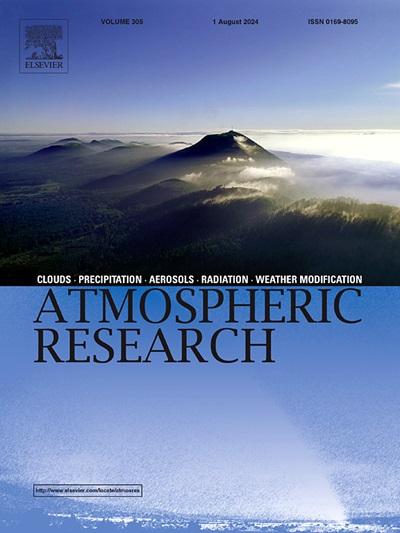Performance comparison of GPM IMERG V07 with its predecessor V06 and its application in extreme precipitation clustering over Türkiye
IF 4.5
2区 地球科学
Q1 METEOROLOGY & ATMOSPHERIC SCIENCES
引用次数: 0
Abstract
Defining regions with similar characteristics for extreme precipitation is crucial for understanding the impacts of climate change, planning and managing water resources, and designing hydraulic structures. However, studies on the regionalization of extreme precipitation for Türkiye are limited, and regional extreme precipitation characteristics are not well defined. In this study, motivated by the need to contribute to this field, homogenous regions for extreme precipitation across Türkiye were determined using the latest version (V07) of Integrated Multi-satellitE Retrievals for GPM (IMERG). We initially validated IMERG V07 estimates using data from 214 ground-based stations and compared the results with its predecessor V06. The results revealed that IMERG showed some notable improvements from V06 to V07 for all seasons, especially in winter. During this season, the correlation coefficient increased from 0.57 to 0.64, the mean absolute bias decreased from 78.22 % to 69.27 %, and the RMSE decreased from 11.10 mm/day to 9.70 mm/day. In V07, while the trend of decreasing accuracy with increasing elevation observed in V06 continues, it has been shown that some notable improvements were achieved in continuous and categorical metrics. We then applied widely used non-hierarchical (K-means) and hierarchical (Ward's method) clustering techniques. To perform this, we first applied Principal Component Analysis (PCA) to reduce the number of variables related to extreme precipitation (e.g. amount, frequency, standard deviation, and seasonality) and geographic characteristics to identify the most significant variables for analysis. The K-means method delineated Türkiye into eight extreme precipitation regions, while the Ward's method resulted in six distinct extreme precipitation regions. We evaluated the results based on the existing extreme precipitation climatology literature for Türkiye and by associating them to known precipitation dynamics, and as a result, we recommended eight precipitation regions determined by the K-means. The identified precipitation regions are expected to contribute to future studies analyzing the effects of climate change and to regional studies on natural disasters resulting from extreme precipitation.GPM IMERG V07与其前身V06的性能比较及其在浙江极端降水聚类中的应用
定义具有相似极端降水特征的区域对于理解气候变化的影响、规划和管理水资源以及设计水工结构至关重要。然而,目前对宁夏极端降水的区域化研究较少,区域极端降水特征也不明确。本研究基于对这一领域贡献的需要,利用最新版本(V07)的综合多卫星反演(IMERG)确定了整个基ye极端降水的均匀区域。我们最初使用214个地面站的数据验证了IMERG V07的估计,并将结果与其前身V06进行了比较。结果表明,从V06到V07, IMERG在所有季节都有明显的改善,特别是在冬季。相关系数从0.57上升到0.64,平均绝对偏差从78.22%下降到69.27%,均方根误差从11.10 mm/d下降到9.70 mm/d。在V07中,虽然V06中观测到的精度随海拔升高而下降的趋势仍在继续,但在连续和分类指标上取得了一些显著的改进。然后,我们应用了广泛使用的非分层(K-means)和分层(Ward方法)聚类技术。为此,我们首先应用主成分分析(PCA)来减少与极端降水相关的变量(如数量、频率、标准差和季节性)和地理特征的数量,以确定最重要的变量进行分析。K-means方法将 rkiye划分为8个极端降水区,而Ward的方法则将其划分为6个不同的极端降水区。我们基于现有的 rkiye极端降水气候学文献对结果进行了评估,并将其与已知的降水动力学联系起来,因此,我们推荐了8个由k均值确定的降水区域。确定的降水区域预计将有助于今后分析气候变化影响的研究和关于极端降水造成的自然灾害的区域研究。
本文章由计算机程序翻译,如有差异,请以英文原文为准。
求助全文
约1分钟内获得全文
求助全文
来源期刊

Atmospheric Research
地学-气象与大气科学
CiteScore
9.40
自引率
10.90%
发文量
460
审稿时长
47 days
期刊介绍:
The journal publishes scientific papers (research papers, review articles, letters and notes) dealing with the part of the atmosphere where meteorological events occur. Attention is given to all processes extending from the earth surface to the tropopause, but special emphasis continues to be devoted to the physics of clouds, mesoscale meteorology and air pollution, i.e. atmospheric aerosols; microphysical processes; cloud dynamics and thermodynamics; numerical simulation, climatology, climate change and weather modification.
 求助内容:
求助内容: 应助结果提醒方式:
应助结果提醒方式:


